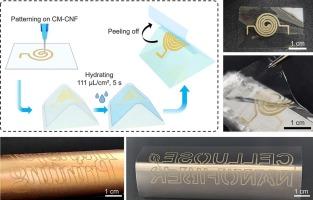利用羧甲基化纤维素纳米纤维薄膜进行导电图案转移印刷的水合触发粘附切换
IF 5.9
3区 工程技术
Q1 CHEMISTRY, MULTIDISCIPLINARY
Journal of Industrial and Engineering Chemistry
Pub Date : 2025-05-14
DOI:10.1016/j.jiec.2025.05.014
引用次数: 0
摘要
复杂的3D设备需要在温和条件下的弯曲几何形状的打印技术。在这里,有效的3D转移打印是通过使用纤维素纳米纤维(CNF)薄膜进行简单的水辅助粘附切换来实现的。印刷在CNF膜上的图案通过CNF膜的简单水化转移到目标表面。随着CNF薄膜逐渐水化,印刷图案与薄膜表面之间的氢键减弱。这种附着力的降低使得CNF膜上的图案很容易分层,并自发转移到目标表面,如聚合物、陶瓷和金属,这些表面比水合CNF表面具有更强的附着力。这种水合触发的工艺既可以在曲面上实现高保真打印,又可以实现电子设备的功能完整性和易于维修,为柔性电子电路的先进制造铺平了道路。本文章由计算机程序翻译,如有差异,请以英文原文为准。

Hydration-triggered adhesion switching for transfer printing of conductive patterns using carboxymethylated cellulose nanofibers films
Complex 3D devices require a printing technique for curved geometries under mild conditions. Here, effective 3D transfer printing is achieved by simple water-assisted adhesion switching using a cellulose nanofiber (CNF) film. Patterns printed on the CNF film are transferred to target surfaces by simple hydration of the CNF film. As the CNF film gradually hydrates, the hydrogen bonding between the printed patterns and the film surface weakens. This reduction in adhesion allows the easy delamination of patterns from the CNF film and the spontaneous transfer to target surfaces such as polymers, ceramics, and metals, which have stronger adhesion than the hydrated CNF surface. This hydration-triggered process enables both high-fidelity printing on curved surfaces and functional integrity and easy repair of electrical devices, paving the way for advanced fabrication of flexible electronic circuits.
求助全文
通过发布文献求助,成功后即可免费获取论文全文。
去求助
来源期刊
CiteScore
10.40
自引率
6.60%
发文量
639
审稿时长
29 days
期刊介绍:
Journal of Industrial and Engineering Chemistry is published monthly in English by the Korean Society of Industrial and Engineering Chemistry. JIEC brings together multidisciplinary interests in one journal and is to disseminate information on all aspects of research and development in industrial and engineering chemistry. Contributions in the form of research articles, short communications, notes and reviews are considered for publication. The editors welcome original contributions that have not been and are not to be published elsewhere. Instruction to authors and a manuscript submissions form are printed at the end of each issue. Bulk reprints of individual articles can be ordered. This publication is partially supported by Korea Research Foundation and the Korean Federation of Science and Technology Societies.

 求助内容:
求助内容: 应助结果提醒方式:
应助结果提醒方式:


